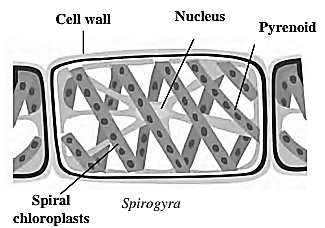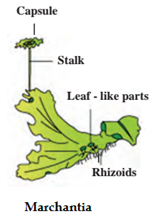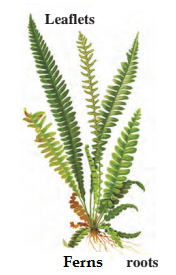Classification of Plants
Maharashtra Board-Class 9-Science & Technology-Chapter-6
Notes
Topics to be learn :
- Kingdom Plantae
- Sub-kingdom – Gymnosperms
- Sub-kingdom – Angiosperms
Introduction: Classification is the process of categorizing things on the basis of properties. Organisms are grouped together when they have common features.
Living organisms have been classified on the basis of their characteristics, their mode of reproduction, habitat and other structural details.
Robert Whittaker (1959) proposed five kingdom system of classification for the study of living organisms. According to Whittaker the five kingdoms are Monera, Protista, Fungi, Plantae and Animalia.
Botanist named Eichler in 1883 classified the kingdom Plantae into two sub-kingdoms viz. Cryptogams and Phanerogams.
Basis for classification of Plants :
- Presence or absence of organs.
- Presence or absence of separate conducting tissues for the conduction of food and water.
- Presence or absence of seeds in plants.
- Whether seeds are enclosed in fruits or not.
- Number of cotyledons in seeds : one or two.
Criteria used for the classification of plants :
Sub-kingdom : Cryptogams
Plants belonging to sub-kingdom Cryptogams reproduce with the help of spores.
Division I - Thallophyta :
- Plants belonging to Division Thallophyta grow mainly in water. Some grow in fresh water, while others grow in marine water.
- These plants do not have specific parts like root, stem, leaves and flowers.
- They are autotrophic owing to the presence of chlorophyll. Such plants are called algae (singular alga).
- Algae show great diversity. They are either unicellular or multicellular. Some are microscopic while others are macroscopic (large).
Examples : Spirogyra, Ulothrix, Ulva, Chara, Sargassum, etc.
Different types of Fungi, such as yeasts and moulds which do not possess chlorophyll have also been (as per old method of classification) included in this group.
| Chloroplasts are the special cell organelles found in plants (They are not found in animal cells) that differentiate plant cells from animal cells. Owing to the presence of chloroplasts plants carry out the process of photosynthesis |
Spirogyra : Spirogyra is a green filamentous alga belonging to the division Thallophyta.

Division II - Bryophyta :
- Plants belonging to the division Bryophyta are called amphibious plants as they grow in moist soil, but need water for reproduction, thus sharing two habitats.
- Plants are mostly thalloid (Exception -Mosses), multicellular and autotrophic.
- The plant body of bryophytes is flat and ribbon like without true roots. Instead of roots they possess rhizoids.
- They do not possess conducting tissues for the conduction of food and water.
- Examples : Funaria (moss), Riccia, Marchantia, Anthoceros, etc.
Marchantia :

Division III - Pteridophyta :
- Plants belonging to Pteridophyta bears well developed roots, stem and leaves but do not bear flowers and fruits.
- They bear separate tissues for the conduction of food and water.
- Pteridophytes reproduce by means of spores which are formed on the posterior side of their leaves.
- Reproduction in Pteridophytes occur asexually by spores and sexually by zygote formation.
- Examples : Nephrolepis, Adiantum, Pteris, Marsilea, Selaginella, Equisetum, Lycopodium, etc.
Ornamental plants : Ornamental plants like fern seen in gardens.

Sub-kingdom — Phanerogams :
- Phanerogams are characterised by the presence of flowers, fruits and seeds.
- Phanerogams are further classified into gymnosperms and angiosperms.
- In gymnosperms the seeds are naked while in angiosperms the seeds are enclosed in fruits.
(1) Division I – Gymnosperms : Gymnos - naked, sperms — seeds (2) Division II — Angiosperms : Angios - concealed or hidden, Sperms - seeds
Difference between Monocot and Dicot : 2-Stem unbranched. 3-Leaves show parallel venation. 4-Flowers with 3 partsor in their multiples. (Trimerous) 5-Examples : Maize, banana, wheat, jowar 2-Stem branched. 3-Leaves show reticulate venation. 4-Flowers with 4 or 5 parts or in their multiples. (Tetra orpentamerous) 5-Examples : Sunflower, mustard beans.
Monocot
Dicot
1-Fibrous root.
1-Tap root.
(1) Hibiscus (A dicot plant) : Root : Tap root Stem : Erect and branched Leaf : Simple, alternate, with reticulate, venation Flower : Pedicillate, complete, bisexual Calyx : Sepals-5, Gamosepalous Corolla : Petals-5, Gamopetalous Androecium : Stamen indefinite. Filaments are united to form a staminal tube. The staminal tube bears reniform (kidney shaped) anthers. Gynooclum : Pentacarpellary, syncarpous
(2) Onion (Alliurn cepa) (A monocot plant): A small herb with tunicated bulb Root : Fibrous Stem : Underground stem (bulb) Leaves : Hollow and tubular Flower : Complete, bisexual Perianth : Made up of 6 lobes, arranged in two whorls of 3 each. Androecium : Made up of 6 stamens, Epiphyllous Gynoecium : Tricarpellary, syncarpous, ovary sperior
Maize (Monocotyledonous plant) : The seed of maize has single cotyledon. The plant has fibrous roots and hollow, false stem. The leaves show parallel venation. Flowers are with trimerous symmetry. Therefore, maize is called monocotyledonous plant.
Useful links :
| Main Page : - Maharashtra Board Class 9th Science & Technology - All chapters notes, solutions, videos, test, pdf.
Previous Chapter : Chapter 5: Acids, Bases and Salts - view online Notes Next Chapter : Chapter 7: Energy Flow in Ecosystem -view online Notes |